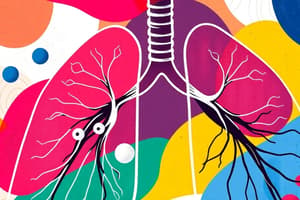Podcast
Questions and Answers
Which of the following actions is primarily associated with sympathomimetics?
Which of the following actions is primarily associated with sympathomimetics?
- Blocks muscarinic receptors
- Inhibits acetylcholine release
- Contracts bronchial smooth muscle
- Stimulates beta2 adrenergic receptors (correct)
What is a common adverse effect of Albuterol?
What is a common adverse effect of Albuterol?
- Headaches (correct)
- Insomnia
- Hypoglycemia
- Nausea
Which condition is Salmeterol indicated for?
Which condition is Salmeterol indicated for?
- Chronic kidney disease
- Hypothyroidism
- Hypertension
- Asthma (correct)
Before which action should Salmeterol be administered to ensure effectiveness?
Before which action should Salmeterol be administered to ensure effectiveness?
What should be monitored when using Salmeterol over time?
What should be monitored when using Salmeterol over time?
What is the main mechanism of action for leukotriene receptor antagonists?
What is the main mechanism of action for leukotriene receptor antagonists?
Which of the following is an adverse effect associated with leukotriene receptor antagonists?
Which of the following is an adverse effect associated with leukotriene receptor antagonists?
What is a specific caution for using leukotriene receptor antagonists?
What is a specific caution for using leukotriene receptor antagonists?
Montelukast is indicated for which of the following conditions?
Montelukast is indicated for which of the following conditions?
When should montelukast be administered in relation to meals?
When should montelukast be administered in relation to meals?
What is the primary mechanism of action of Ipratropium?
What is the primary mechanism of action of Ipratropium?
Which of the following is a common side effect of Ipratropium?
Which of the following is a common side effect of Ipratropium?
Which condition is Ipratropium primarily used to treat?
Which condition is Ipratropium primarily used to treat?
What is the primary use of Theophylline in patients?
What is the primary use of Theophylline in patients?
Which of the following is a contraindication for using Xanthines?
Which of the following is a contraindication for using Xanthines?
What adverse effect is associated with the use of Theophylline?
What adverse effect is associated with the use of Theophylline?
What is the advantage of Ipratropium over other bronchodilator drugs?
What is the advantage of Ipratropium over other bronchodilator drugs?
What conditions may be treated if renal or other drugs have failed?
What conditions may be treated if renal or other drugs have failed?
Which of the following are common gastrointestinal side effects?
Which of the following are common gastrointestinal side effects?
Which cardiovascular effects may occur with this therapy?
Which cardiovascular effects may occur with this therapy?
What is the suggested therapeutic level for the medication?
What is the suggested therapeutic level for the medication?
What effect does smoking have on medication metabolism?
What effect does smoking have on medication metabolism?
Which of the following should be avoided when taking this medication?
Which of the following should be avoided when taking this medication?
What complications may arise from rapid IV administration?
What complications may arise from rapid IV administration?
What are the potential effects on blood glucose levels?
What are the potential effects on blood glucose levels?
Which of the following is NOT a noted side effect of this medication?
Which of the following is NOT a noted side effect of this medication?
What may occur if there is an increased requirement for the dosage?
What may occur if there is an increased requirement for the dosage?
Flashcards
Albuterol Action
Albuterol Action
Albuterol stimulates beta2 adrenergic receptors in the lungs, relaxing bronchial smooth muscle, leading to bronchodilation.
Albuterol Adverse Effects
Albuterol Adverse Effects
Albuterol can cause CNS effects like tremors, headaches, and restlessness, and CV effects like tachycardia and palpitations.
Salmeterol Use
Salmeterol Use
Salmeterol is a long-acting bronchodilator, used for asthma and COPD prophylaxis, usually taken before exercise.
Salmeterol Adverse Effect
Salmeterol Adverse Effect
Signup and view all the flashcards
Anticholinergic Action
Anticholinergic Action
Signup and view all the flashcards
Ipratropium action
Ipratropium action
Signup and view all the flashcards
Ipratropium uses
Ipratropium uses
Signup and view all the flashcards
Xanthines MOA
Xanthines MOA
Signup and view all the flashcards
Xanthine example
Xanthine example
Signup and view all the flashcards
Xanthines uses
Xanthines uses
Signup and view all the flashcards
Ipratropium side effects
Ipratropium side effects
Signup and view all the flashcards
Xanthine side effects
Xanthine side effects
Signup and view all the flashcards
Betablocker toxicity
Betablocker toxicity
Signup and view all the flashcards
Leukotriene Receptor Antagonists action
Leukotriene Receptor Antagonists action
Signup and view all the flashcards
Montelukast use
Montelukast use
Signup and view all the flashcards
Leukotriene Receptor Antagonists side effects
Leukotriene Receptor Antagonists side effects
Signup and view all the flashcards
Montelukast administration
Montelukast administration
Signup and view all the flashcards
PD Bronchodilation
PD Bronchodilation
Signup and view all the flashcards
PD Administration Routes
PD Administration Routes
Signup and view all the flashcards
PD Therapeutic Level
PD Therapeutic Level
Signup and view all the flashcards
PD Side Effects (GI)
PD Side Effects (GI)
Signup and view all the flashcards
PD Side Effects (CV)
PD Side Effects (CV)
Signup and view all the flashcards
Smoking and PD Metabolism
Smoking and PD Metabolism
Signup and view all the flashcards
PD Interactions with other medication
PD Interactions with other medication
Signup and view all the flashcards
PD and Decreased Clotting
PD and Decreased Clotting
Signup and view all the flashcards
Avoid Caffeinated Products with PD
Avoid Caffeinated Products with PD
Signup and view all the flashcards
PD IV administration Caution
PD IV administration Caution
Signup and view all the flashcards
Study Notes
Lower Respiratory Disorders - Medications
-
Sympathomimetic/Beta2-Adrenergic Agonists:
- Albuterol: Stimulates beta2 receptors in lungs, relaxing bronchial smooth muscle, causing bronchodilation. Used to treat asthma and prophylaxis.
- Adverse effects: Tremors, tachycardia, palpitations, headache, cardiac dysrhythmias, and anxiety.
- Salmeterol: Long-acting bronchodilator, used for maintenance therapy in asthma/COPD.
- Adverse effects: palpitations, tachycardia, headache, tremor, and hyperglycemia
- Caution: Monitor glucose levels, especially with high-dose use. Use cautiously in patients with cardiac disease.
-
Anticholinergics:
- Ipratropium: Blocks muscarinic receptors, inhibiting acetylcholine and relaxing bronchial smooth muscle, reducing bronchospasm. Commonly used in COPD.
- Adverse effects: Headache, blurred vision, dry mouth, dyspepsia, and glaucoma.
- Caution: Assess for allergy to soy or peanuts.
-
Xanthines:
- Aminophylline: Inhibits phosphodiesterase, increasing cAMP levels and causing bronchodilation. Used for maintenance therapy in chronic stable asthma.
- Adverse effects: CNS (irritability, headache, seizures), GI (nausea, vomiting, diarrhea, anorexia), CV (tachycardia, palpitations, hypotension), and others.
- Caution: Contraindicated in patients with known seizures, cardiac issues, or liver disease. Monitor serum drug levels.
-
Theophylline:
- Action: Increases cAMP, leading to bronchodilation. Used for asthma and COPD.
- Adverse effects: CNS, GI, CV, (e.g. restlessness, insomnia, dizziness, palpitations tachycardia.)
- Therapeutic level: 10-20 mcg/mL.
- Considerations: Monitor blood levels and avoid caffeine. Risk of digoxin toxicity increased if given IV.
-
Leukotriene Receptor Antagonists:
- Montelukast: Inhibits leukotriene receptors, reducing bronchospasm and inflammation. Used to treat asthma and allergies.
- Adverse effects: headache, dizziness, insomnia, and gastrointestinal issues.
- Caution: Not for acute asthma attacks.
-
Inhaled Steroids:
- Budesonide: Inhaled corticosteroid used to reduce inflammation and improve breathing. Used in asthma, especially for prevention.
- Adverse effects: Headache, dizziness, and local irritation.
General Considerations
- Medication use should follow physician recommendations.
- Monitoring patient responses to medications is essential.
- Patients should be educated about potential adverse effects and associated cautions.
Studying That Suits You
Use AI to generate personalized quizzes and flashcards to suit your learning preferences.


